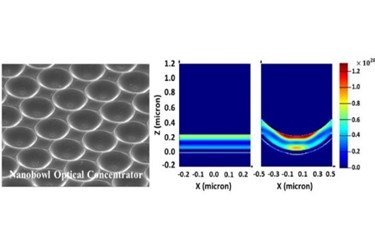Researchers At HKUST Achieved Novel Nanobowl Optical Concentrator For Organic Solar Cell

Geometrical light trapping is a simple and promising strategy to largely improve the optical absorption and efficiency of solar cells. Nonetheless, implementation of geometrical light trapping in organic photovoltaic (OPV) is challenging due to the fact that uniform organic active layer can rarely be achieved on textured substrate. Professor Zhiyong Fan and his group from Hong Kong University of Science and Technology (HKUST) reported novel nanobowl optical concentrator fabricated on low-cost aluminum foil and aiming at tackling this problem. They have successfully fabricated OPV devices based on such optical concentrator and demonstrated over 28 % enhancement in power conversion efficiency over the devices without nanobowl.
Solar energy is one of the most promising renewable energy resources and represents a clean and ultimate replacement for fossil fuels in the future. Over the past decades, enormous efforts have been invested in developing efficient and cost effective photovoltaic devices which are competitive to the fossil fuel. Organic photovoltaic (OPV) has been regarded as one of the promising candidates for large-scale, low-cost and efficient solar energy harvesting. Typical OPV devices are fabricated on glass substrate and using indium-doped tin oxide as electrode. However, such substrate is not flexible and the relatively high resistance of ITO electrode will compromises the OPV device performance. Comparatively, an aluminum foil substrate has the advantages of excellent conductivity, flexibility, cost-effectiveness and roll-to-roll processibility. Meanwhile, light trapping by nano-textured substrate is an appealing strategy to improve solar cell efficiency. Nonetheless, such application for OPV has yet been successfully demonstrated up to now. This is partly due to the more stringent requirement on active layer thickness uniformity for OPV devices and such uniformity is hard to be guaranteed on nano-texture with the existing coating techniques.
The novel nanobowl optical concentrator developed by Professor Zhiyong Fan can largely enhance the optical absorption in the active layer of organic solar cell and optical simulation revealed that such improvement was contributed by the superior photon capturing capability of the nanobowl. In addition, they have investigated the effect of geometry of nanobowl on the solar cell performance and three types of nanobowl with pitch of 1000 nm, 1200 nm and 1500 nm were studied. Solar cells based on nanobowl with pitch of 1000 nm exhibited the best photon absorption in photoactive layer leading to the highest short-circuit current density of ~9.41 mA cm-2 among all nanobowl substrates. With open-circuit voltage of 0.573 V and fill factor of 57.9 %, this nanobowl solar cell achieved a solar energy conversion efficiency of 3.12 %, which is 28 % improvement over the control device without nanobowl. This work not only revealed the in-depth understanding of light trapping by nanobowl optical concentrator, but also demonstrated the feasibility of implementing geometrical light trapping in low-cost, solution processible OPV.
The development of the novel nanobowl optical concentrator and its application on OPV were a collaborative effort involving Professors in Department of Chemistry of HKUST including Professor Shihe Yang and Professor He (Henry) Yan, who are working on cutting-edge researches about organic photovoltaics. The research project was supported by General Research Funds from Hong Kong Research Grants Council and Hong Kong Innovation Technology Commission.
Source: Science China Press
